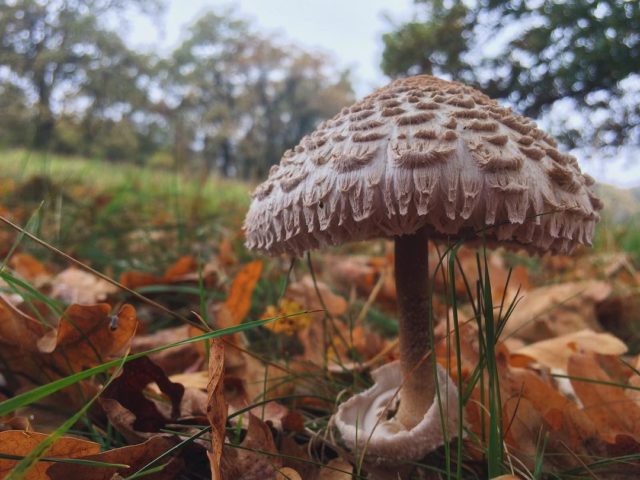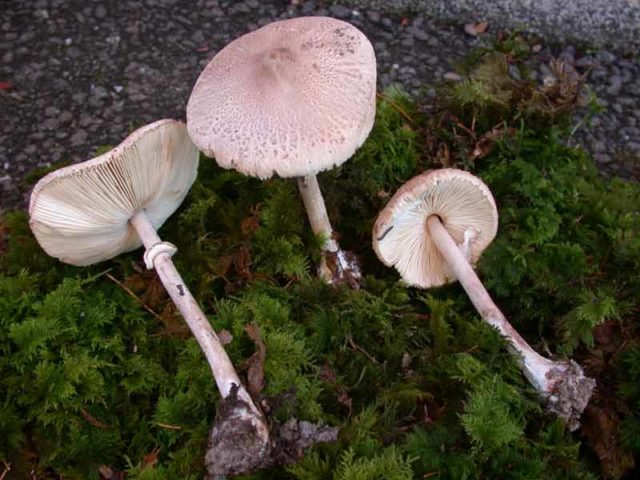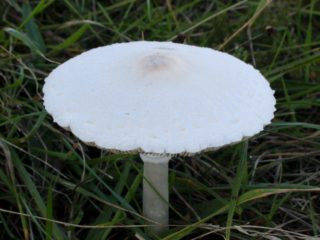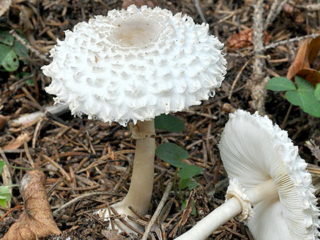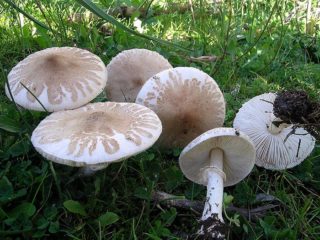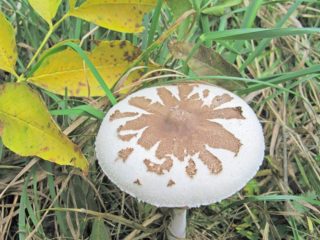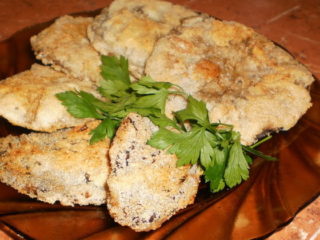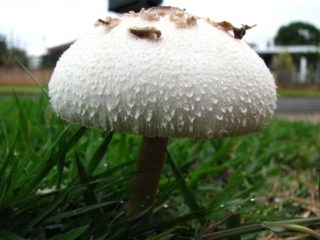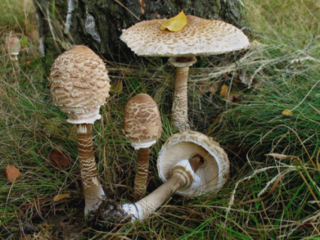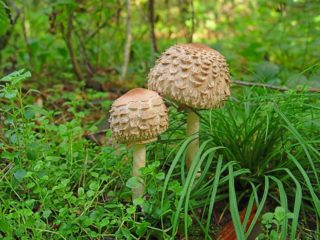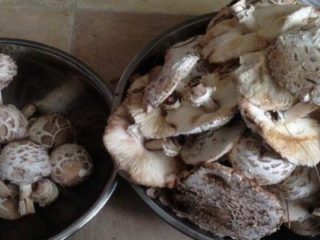Content
- 1 Where does the big umbrella mushroom grow?
- 2 What does a tall umbrella mushroom look like?
- 3 Is the variegated umbrella mushroom edible or not?
- 4 Useful properties of the big umbrella mushroom
- 5 False doubles of the variegated umbrella mushroom
- 6 Rules for collecting a large motley umbrella
- 7 How to cook variegated umbrella mushroom
- 8 Growing variegated umbrella mushrooms
- 9 Conclusion
The variegated umbrella mushroom belongs to the Champignon family. It is often called differently: big, tall, royal champignon. And in some areas - chicken coop, since it, cooked in butter, resembles the taste of chicken meat.
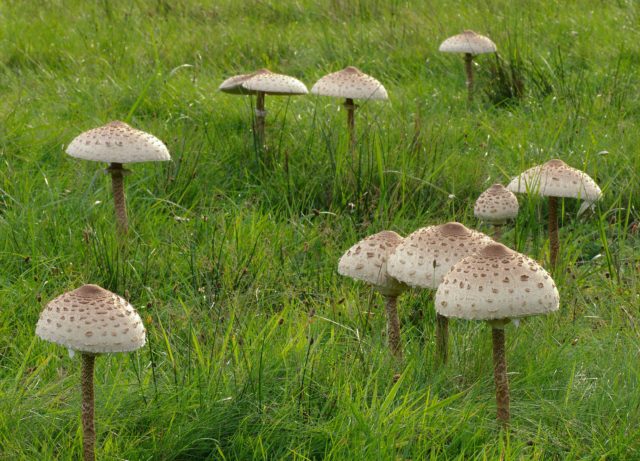
Mushrooms are very noticeable in size
Where does the big umbrella mushroom grow?
The variegated umbrella, or macrolepiota procera in Latin, is distributed on all continents.It is also found everywhere in Russia - on fertile soil rich in organic residues with a light structural composition. Mushrooms of the species are saprotrophs, feeding on decaying organic matter. The fruiting bodies of variegated umbrellas prefer to grow in open spaces of forest edges, clearings, meadows, city parks and squares. They can easily be found in clearing areas, along roads, in unplowed fields, pastures and gardens. They grow singly or in groups. In this case, the mycelium is often located in a spacious area, creating rows or so-called “witch circles”, where from 15 to 30 fruiting bodies are formed. The variegated variety bears fruit from mid-June to the end of September.
What does a tall umbrella mushroom look like?
Young mushrooms are variegated umbrellas, as in the photo - ovoid, from a distance they seem fluffy. The leg with a rounded top begins to rise first, and then the cap opens. Because of this characteristic feature, in Italy the species is called “drumsticks”. The open cap is wide-conical, one of the largest: adult fruiting bodies reach a diameter of 15-24 to 32-35 cm. In the middle of the fibrous gray-beige cap there is a tubercle, the shade of the skin is darker - brownish, without scales. Sometimes it is whitish-gray, sometimes with brown tints. Light brown triangular small scales always remain over the entire surface, except for the central part, which are easily separated. The edges of the cap are slightly curved downwards, covered with scales.
The white plates of young mushrooms are whitish or light beige, become brown in old ones, and are densely located.Near the stem, a mass of plates forms a cartilaginous compaction. The white, loose pulp becomes denser with age; the color remains the same when cut. A mushroom or sweetish nutty aroma emanates from the fruiting body. A peculiarity of the species is that the cap is easily separated from the stem, just as the plates are freely torn off from the base of the cap. The mass of spores is white or slightly cream-colored.
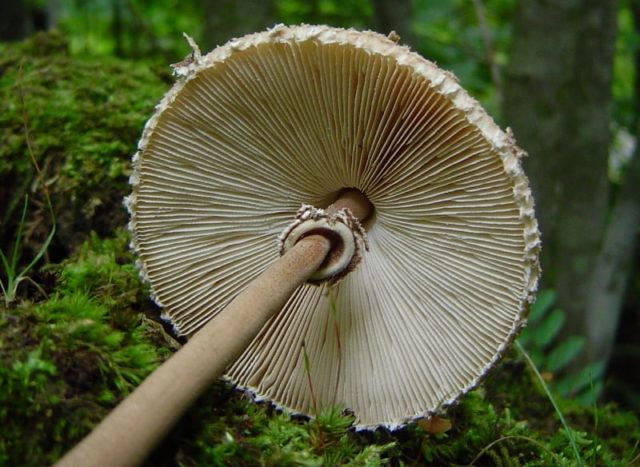
The ring on the leg moves
In young representatives of the species, the leg is light brown, turns brown with age, and dense, dark scales form on the surface. Sometimes everything is covered with alternating dark and light stripes. The height of the stem of a variegated umbrella is from 15 to 40 cm. Mushroom pickers claim that they have encountered umbrellas 60 cm high. The diameter of the thin stem is 3 cm, rarely 4 cm. It is hollow in structure, with hard fibers. High under the cap there is a membranous ring, usually wide, it is a remnant of the original blanket in which the young mushroom emerges from the ground. Umbrella mushrooms, like champignons, do not have a sac-shaped volva. There is a noticeable thickening near the ground.
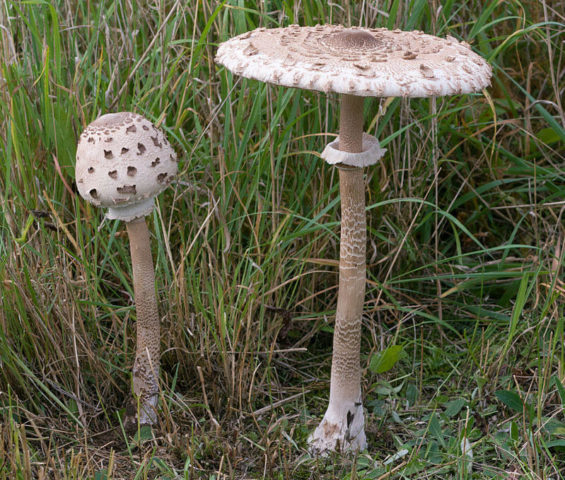
The species has a variegated cap and leg
Is the variegated umbrella mushroom edible or not?
The species is edible. According to nutritional value, it belongs to the 4th category. Many mushroom pickers consider dishes made from umbrella caps to be the most delicious.
Useful properties of the big umbrella mushroom
The fruiting bodies of variegated umbrellas contain a lot of water and fiber, proteins, a balanced amount of carbohydrates and fats. The pulp is valuable for the presence of minerals, B vitamins, as well as C and E and low calorie content.Since the caps are also consumed raw, mushrooms are considered an ideal dietary product, acceptable for weight loss and diabetes, and valuable for vegetarians because it:
- saturates quickly;
- stimulates digestion;
- removes cholesterol;
- alleviates the condition of cancer patients;
- promotes rejuvenation of the body;
- supports the tone of the nervous system and brain activity.
Adherents of traditional medicine use the prepared raw materials to treat stomach diseases, gout, rheumatism, and purulent wounds.
False doubles of the variegated umbrella mushroom
The fruiting bodies of variegated umbrella mushrooms, judging by the photo, are similar to the edible and poisonous ones of some species of the Champignon and Amanitaceae families. Of these, edible umbrellas:
- blushing, which is distinguished by the change in air from whitish pulp to reddish;
- elegant, which is much smaller in size.
From the photo it is easy to confuse the species in question and the poisonous rare dark brown chlorophyllum, which is found in North America and the forests of the Western Carpathians.
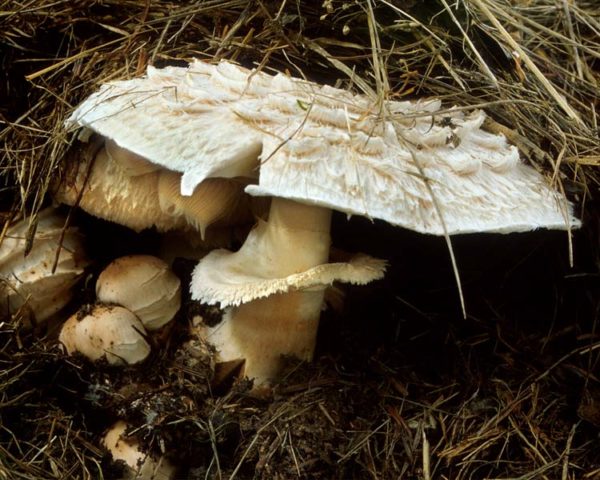
Chlorophyllum is a dangerous mushroom, but is not found in Russia
Often, inexperienced mushroom pickers mistake the variegated umbrella for poisonous:
panther fly agaric;
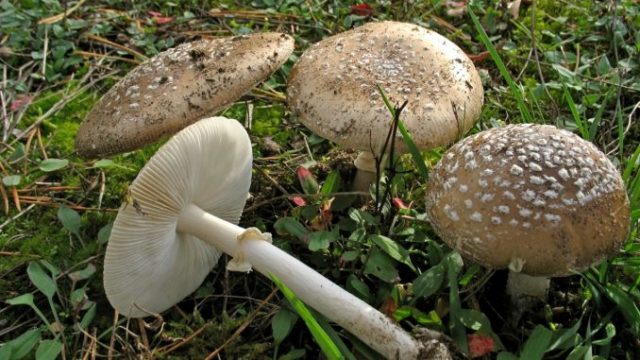
The panther fly agaric has a reddish tip
pale grebe.
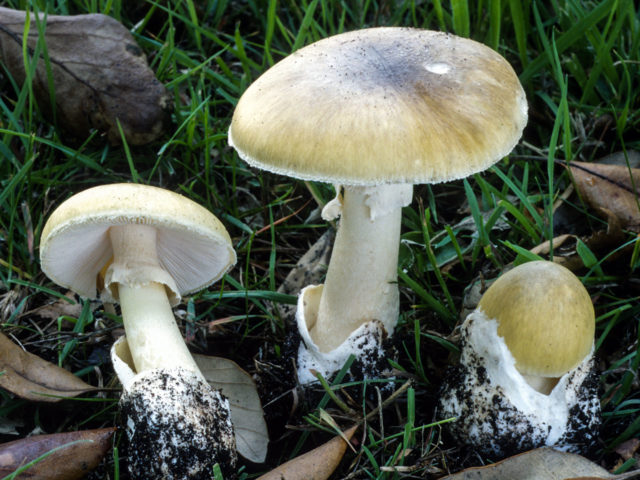
The pale grebe is noticeable by the greenish-yellow tint of its cap.
The motley species differs from the poisonous ones in the following ways:
- the ring on the stem moves easily;
- near the ground there is no pouch on the leg, which remains from the bedspread, like that of the fly agaric and pale toadstool;
- the scales on the cap are numerous, fused in the center, while on fly agarics they are small and sparse;
- A distinctive feature of the pale grebe, except for the volva, is a greenish-olive top;
- The umbrellas of poisonous species are distinguished by the fact that they are very small compared to the size of large and tall motley ones.
Rules for collecting a large motley umbrella
Delicious mushrooms are collected only when the different species are well identified. If in doubt, it is better to leave them in the forest. Known species should not be taken from contaminated areas:
- near industrial zones;
- in the vicinity of large cities;
- along busy roads.
How to cook variegated umbrella mushroom
Caps are most often used for food consumption; they are:
- fried whole or sliced;
- dried;
- marinate;
- frozen cooked or fried;
- eaten raw.
The stems are tough, so they are usually dried and then ground into mushroom powder, which is used to season soups.
Recipes for quick cooking of the motley umbrella are the most unsophisticated - omelettes, scrambled eggs, salted raw cap along with vegetables.
Growing variegated umbrella mushrooms
Today, they purchase mycelium in specialized stores or bring ripe mushrooms and scatter the spores in shady, damp places from February to May. The area is cultivated, the turf is not removed, but the mycelium or spore mass is sprinkled with a layer of humus. Fruiting begins after 3-5 months and continues until 5-6 years.
Conclusion
The variegated umbrella mushroom is considered tasty; lovers not only collect it, but also grow the species. On a quiet hunt, the main thing is an unshakable rule: avoid unknown myceliums.
